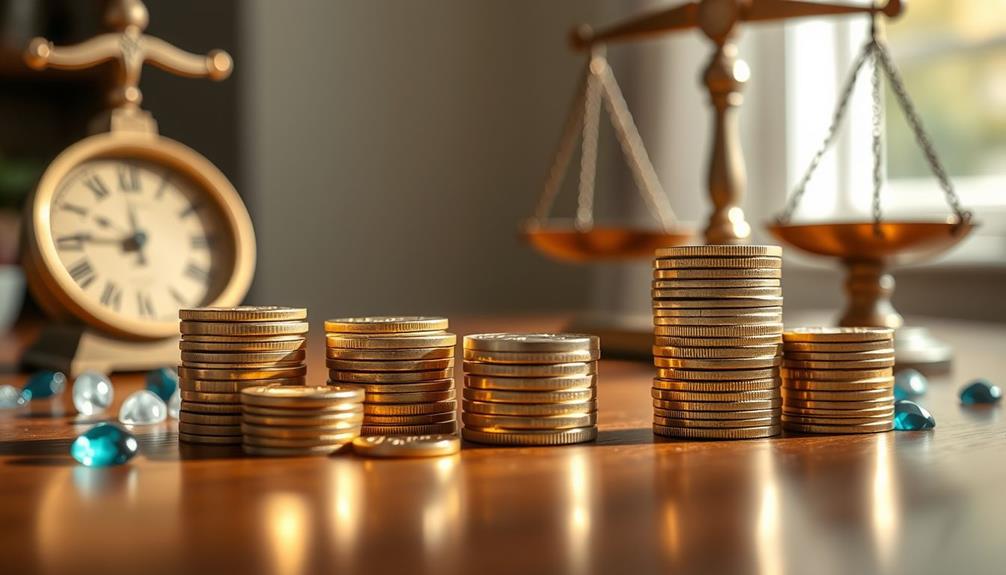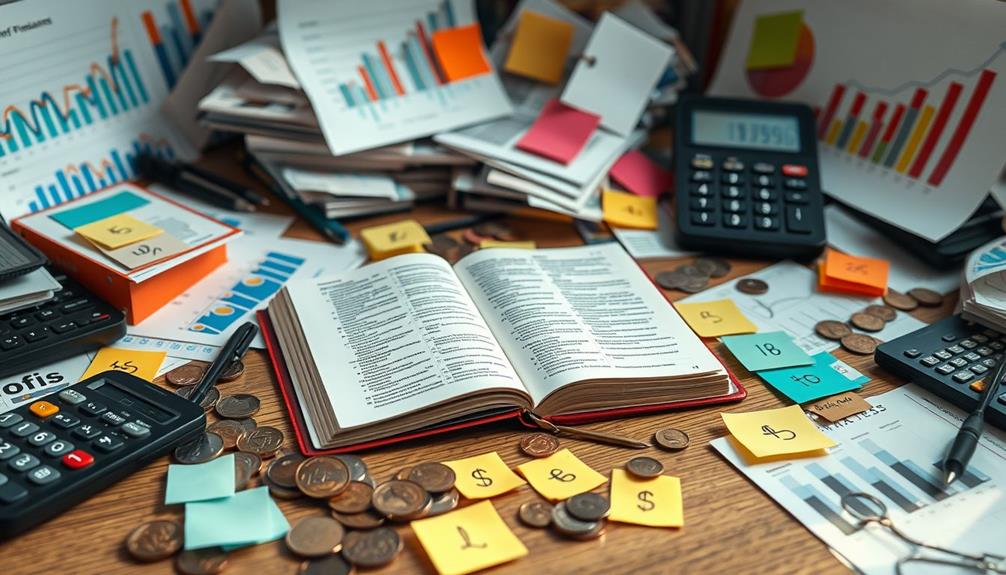Investing in precious metals like gold and silver can be a smart way to diversify your portfolio and protect your wealth. These metals act as a hedge against inflation and market volatility, maintaining their value when fiat currencies fluctuate. You can choose between physical ownership or paper investments like ETFs. Each option has its pros and cons, so it's crucial to align your choice with your financial goals. Keep in mind potential risks, including market volatility and costs associated with physical ownership. There's a lot more to explore, so you'll want to check out additional insights on this topic!
Key Takeaways
- Precious metals like gold, silver, platinum, and palladium serve as tangible assets and can hedge against inflation and economic uncertainty.
- Investors should consider diversifying their portfolios by allocating 5% to 10% of assets to precious metals for stability.
- Investment options include physical ownership, ETFs, and mining stocks, each with unique benefits and risks.
- Market volatility, lack of cash flow, and storage costs are risks to consider when investing in precious metals.
- Research reputable providers to avoid scams and understand the tax implications associated with precious metal investments.
Overview of Precious Metals
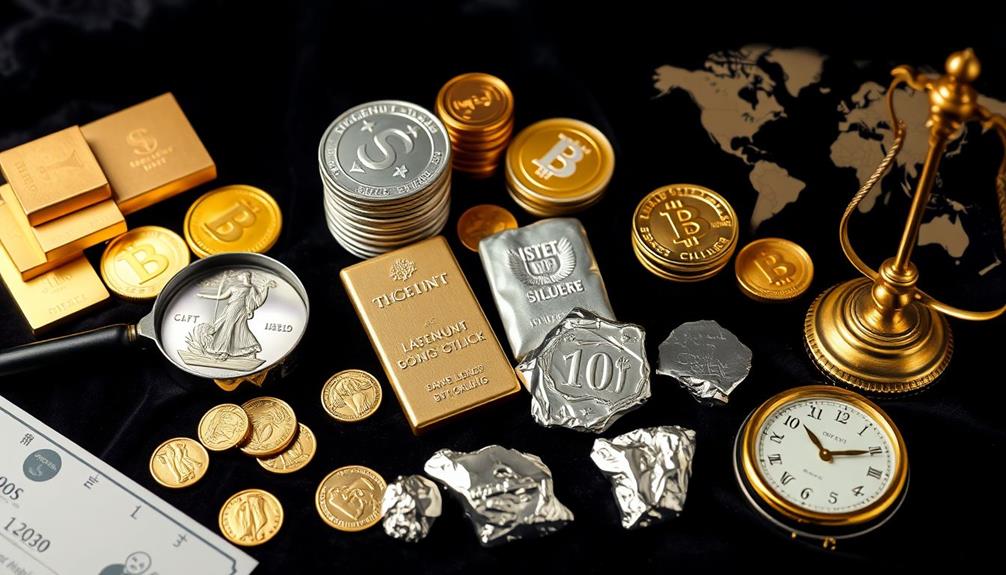
When it comes to investing, understanding the allure of precious metals can be pivotal. These metals, including gold, silver, platinum, and palladium, hold significant value due to their scarcity and diverse applications.
Gold stands out as the most recognized precious metal, often regarded as a safe-haven investment during periods of market volatility and economic uncertainty. It's durable and has a long history as a store of value, making it an attractive option for benefits of converting 401k to Gold IRA as part of a diversified retirement portfolio.
Silver, on the other hand, serves a dual purpose. While it's a reliable store of value, its price can be more volatile, influenced by fluctuations in industrial demand and supply dynamics.
Platinum is rarer than gold and is heavily utilized in automotive catalysts and jewelry. Its prices are particularly sensitive to geopolitical conditions, especially given the concentration of mining operations in South Africa and Russia.
Palladium, known for its unique industrial applications, has gained traction, especially in electronics and catalytic converters. Its limited supply sources further amplify its demand.
Characteristics of Precious Metals
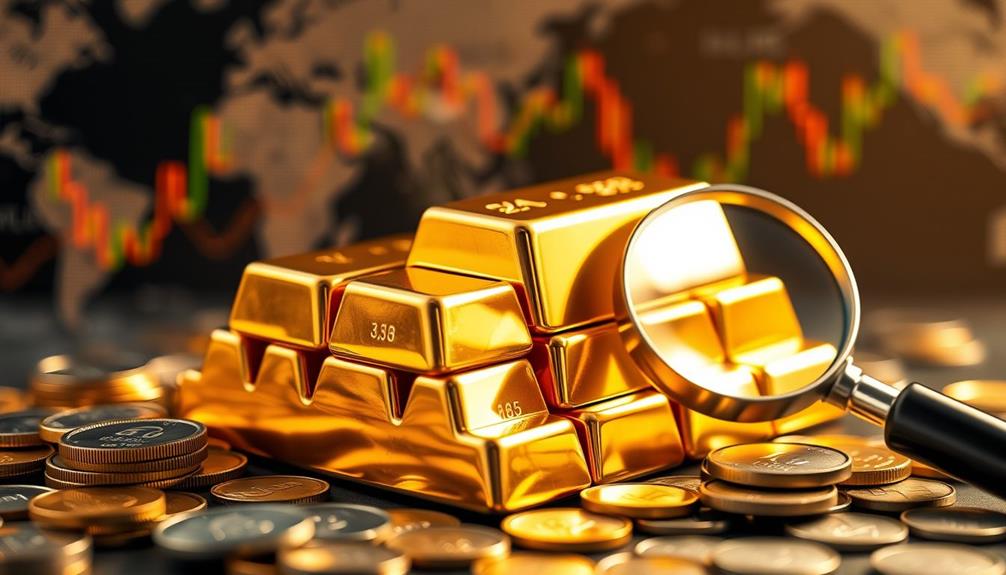
Investors should recognize the distinct characteristics that define precious metals and their unique roles in both the economy and investment strategies.
These metals, including gold, silver, platinum, and palladium, have specific traits that make them appealing for both investment purposes and industrial uses. In addition, diversifying your retirement portfolio with precious metals can enhance financial security and protect against market volatility, making them an essential component of a well-rounded investment strategy.
Here are some key characteristics:
- Rarity: Precious metals are rare, contributing notably to their high economic value.
- Gold: Known for its durability and resistance to corrosion, gold is often viewed as a safe-haven asset during economic uncertainty. Gold IRA Rollovers provide an avenue for investors to protect their retirement savings.
- Silver: This metal serves a dual purpose as both a store of value and an industrial metal, with demand influenced by technology sectors like electronics and solar panels.
- Platinum: Rarer than gold, platinum's price is affected by geopolitical conditions and is widely used in automotive catalysts and jewelry.
- Palladium: Known for its industrial applications, particularly in catalytic converters, palladium can experience considerable price fluctuations due to concentrated supply and specific demand.
Understanding these characteristics can help you navigate the complexities of investing in precious metals effectively.
Investment Strategies for Precious Metals
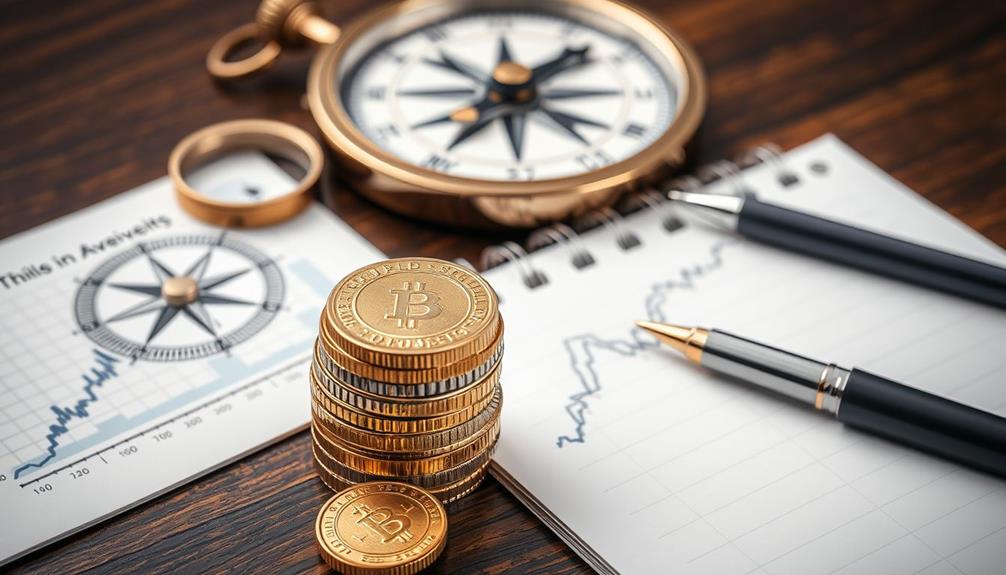
When it comes to investing in precious metals, diversification is your best friend.
You'll want to weigh the benefits of physical ownership against paper investments like ETFs, as each offers distinct advantages and risks.
For example, companies like Noble Gold provide a range of IRA options that can help you secure your retirement savings with precious metals.
Understanding these options can help you craft a strategy that aligns with your financial goals.
Diversification Benefits Explained
Diversifying your portfolio with precious metals like gold and silver can greatly enhance your investment strategy, especially during turbulent market conditions. By incorporating these assets, you can effectively reduce overall risk and improve your portfolio resilience.
Additionally, many investors are increasingly recognizing the potential tax advantages of IRA rollovers to gold as a strategic move for retirement planning. Here are some key benefits of adding precious metals to your investment options:
- Low Correlations: Precious metals often have low or negative correlations with traditional stocks and bonds, providing a buffer during market volatility.
- Hedge Against Inflation: Allocating 5% to 10% of your portfolio to precious metals can help preserve purchasing power during inflationary periods.
- Wealth Preservation: Historically, gold and silver have proven effective in preserving wealth, especially during currency devaluation and crises.
- Crisis Performance: The value of precious metals tends to increase during economic downturns and geopolitical instability, contrasting with potential declines in other asset classes.
- Diverse Metals: By including a mix of gold, silver, platinum, and palladium, investors can enhance their portfolio's resilience as each metal reacts differently to market conditions.
Incorporating precious metals into your investment strategy can provide stability and long-term growth.
Physical Vs. Paper Investments
In the world of precious metals, you face an essential decision: should you invest in physical assets like gold bars and silver coins or opt for paper investments such as ETFs and mining stocks?
Physical precious metals offer tangible value and serve as a direct hedge against inflation, making them a valuable component of a diversified portfolio with options like Gold IRA rollover providing added security. However, they come with costs like secure storage, insurance, and premiums that can eat into your returns.
On the other hand, paper investments provide liquidity and ease of trading, allowing you to avoid the hassles of physical ownership. They can generate dividends and capital appreciation, especially if you invest in well-performing mining companies.
Yet, be mindful of the risks associated with market volatility and the potential for underperformance compared to actual metal prices.
Your choice should align with your investment goals and risk tolerance. If you prioritize security during economic uncertainty, physical investments might be the way to go. If you're aiming for growth potential and can handle market swings, paper investments could be more suitable.
Ultimately, understanding the advantages and drawbacks of each option will help you make an informed decision in your journey of investing in precious metals.
Benefits of Precious Metal Investments
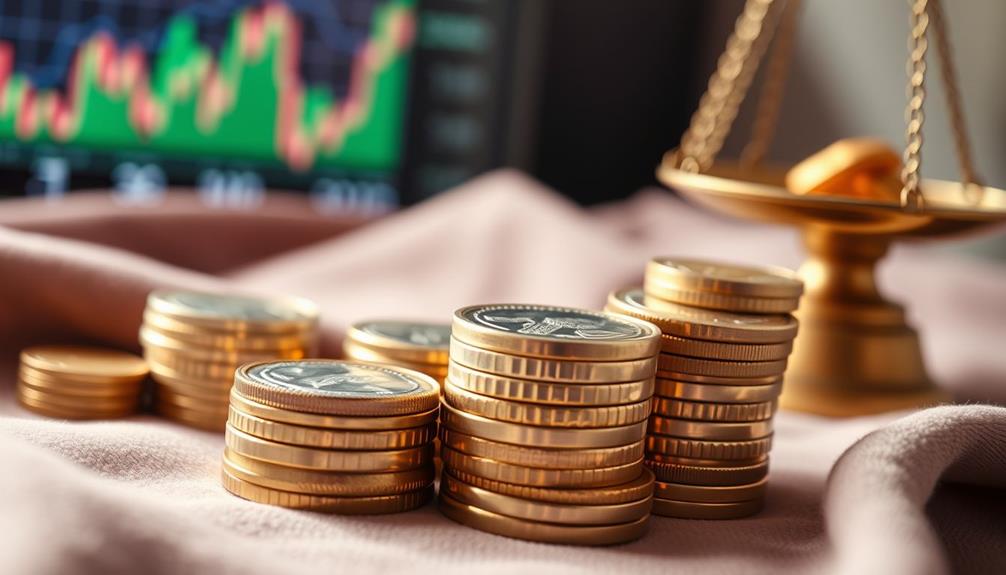
Precious metal investments offer a unique blend of security and opportunity that can enhance your financial portfolio. By adding precious metals like gold and silver, you're not just investing; you're protecting your wealth against various economic challenges.
Gold IRAs, specifically, provide a tax-advantaged way to invest in physical gold, helping to diversify retirement portfolios beyond traditional assets a hedge against inflation.
Here are some key benefits of investing in precious metals:
- Hedge against inflation: Precious metals often maintain their value when fiat currencies decline.
- Tangible asset: Unlike stocks, gold and silver are physical assets that aren't subject to credit risk.
- Safe-haven asset: During economic uncertainty, these metals typically see price increases, providing a reliable refuge.
- Diversification: Including precious metals in your investment portfolio can reduce overall portfolio volatility.
- Mitigating market fluctuations: Even a small allocation of 5% to 10% in precious metals can stabilize performance and help you navigate turbulent markets.
Incorporating these benefits can enhance your portfolio's resilience and offer peace of mind in uncertain times.
Risks of Investing in Precious Metals

Investors often overlook the risks associated with precious metal investments, which can lead to unexpected challenges. Price volatility is a major concern; market prices can swing dramatically due to global economic conditions and geopolitical events.
Unlike traditional investments, precious metals don't generate cash flows, so your returns depend solely on price appreciation, which can be unpredictable. Additionally, it's important to research reputable providers to avoid potential scams, similar to avoiding Gold IRA scams.
When dealing with physical metals, you'll face additional costs for storage and insurance, and the risk of theft can have notable financial implications.
If you're considering investment products like mining stocks, be aware of company-specific risks such as mismanagement and operational inefficiencies that may cause these stocks to underperform compared to the underlying metal prices.
Moreover, tax rates on profits from precious metals can be higher than those on long-term capital gains from other investments, further reducing your overall returns.
It's vital to weigh these risks carefully against the potential benefits before diving into precious metal investments, as the challenges can impact your financial goals considerably. Understanding these factors will help you make more informed decisions and better prepare for the inherent uncertainties.
Types of Precious Metals
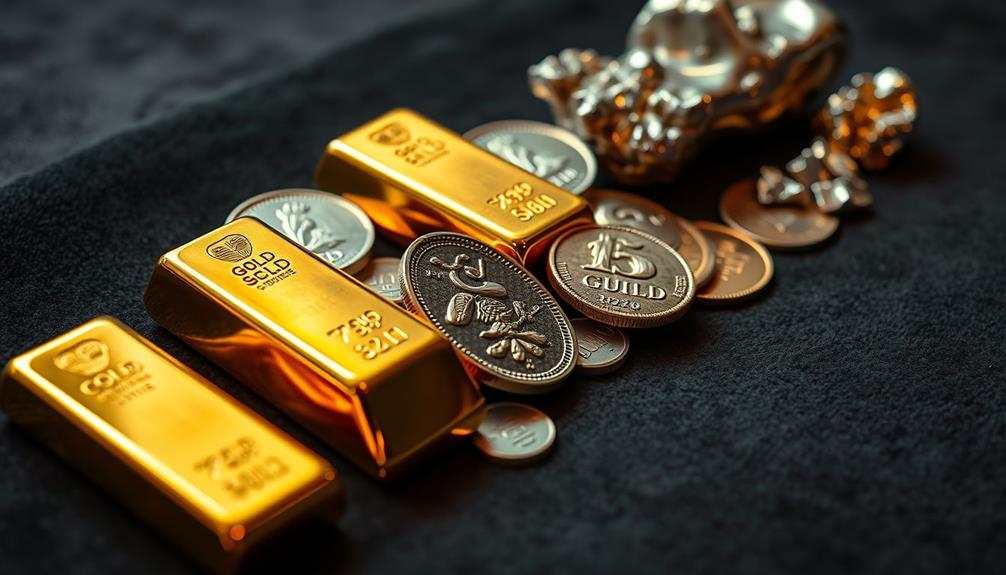
Several types of precious metals offer unique investment opportunities, each with its own characteristics and market behaviors. Understanding these differences can help you make informed choices in your investment journey.
Additionally, just as choosing the right breed can greatly impact your experience as a pet owner, selecting the right precious metal can influence your investment success. For example, exploring unique Akita names for exotic breeds can be likened to discovering the lesser-known aspects of each metal's market dynamics.
- Gold: The most recognized precious metal, known for its durability and malleability. It's widely used in jewelry and as a safe haven during economic uncertainty.
- Silver: This metal shows notable volatility due to its dual role as both a store of value and an industrial metal. Its applications in electronics and solar technology can greatly influence price movements.
- Platinum: Rarer than gold, platinum is primarily utilized in automotive catalytic converters and high-end jewelry. Its limited mining locations often lead to a premium price.
- Palladium: Less known than gold and silver, palladium is sourced mainly from Russia and South Africa. It's sensitive to automotive industry demands, making its market dynamics unique.
- Industrial Metals: Some precious metals, like silver and palladium, have strong industrial uses that can affect demand and prices.
How to Invest in Precious Metals

When considering how to invest in precious metals, it's essential to evaluate the various methods available, as each approach offers distinct advantages and challenges.
You can choose to invest in physical gold or silver, which allows for tangible ownership but involves storage and insurance costs. Additionally, it's important to guarantee that any payment solutions utilized for purchasing these assets are secure and compliant with regulations, especially when dealing with high-value transactions.
If you prefer liquidity, Exchange-Traded Funds (ETFs) and commodity ETFs provide exposure to precious metals without the hassle of physical storage, though be mindful of management fees that could impact your returns Top Firearm Payment Processors.
Another option is investing in mining stocks, which can offer leverage to the price of gold and potential dividends. However, keep in mind that these stocks come with unique risks tied to the companies themselves, and their performance may not always align with metal prices.
To mitigate risks associated with price volatility and market fluctuations, consider diversifying investments across multiple precious metals like gold, silver, platinum, and palladium.
By doing so, you'll be better positioned to navigate the complexities of the market while maximizing your investment potential.
Ultimately, understanding each method's pros and cons is key to making informed decisions in your precious metals investment journey.
Frequently Asked Questions
What Is the Best Precious Metal to Invest in Right Now?
The best precious metal to invest in right now depends on your risk tolerance and market outlook. Gold offers stability, while silver shows growth potential. Consider diversifying across metals to balance risk and maximize returns.
How Do I Start Investing in Precious Metals?
Start smartly by setting specific savings goals. Study various metals, select your strategy—stocks, ETFs, or bullion. Stay savvy by monitoring market movements and understanding associated costs. This groundwork gets you going on your investment journey.
Is It Wise to Invest in Precious Metals?
Investing in precious metals can be wise, especially during economic uncertainty. They often retain value when currencies decline. Just remember to diversify your portfolio and only allocate a portion for balanced risk management.
How Do Beginners Invest in Gold and Silver?
To start investing in gold and silver, you can buy physical bullion, invest in ETFs, or consider mining stocks. Just remember to research market trends and allocate a small percentage of your portfolio for balance.
Conclusion
In a world where everything seems to lose value, it's ironic that shiny rocks like gold and silver still manage to shine brighter than most investments. By choosing to invest in precious metals, you're not just buying into a trend; you're securing a piece of history. So, while everyone else is chasing after the latest tech stock, you can sit back, relax, and watch your glittering treasures remind you that sometimes, old is gold—literally!

